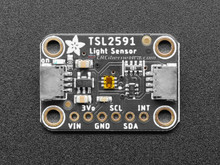 Loading... Please wait...
Loading... Please wait...Categories
- 3D Filament
- Laser Parts
- 3D Printers
- 3D Printer Parts
- Microcontrollers and FPGA
- Shields and daughter boards
- Official Arduino
- Batteries
- Cases and Enclosures
- Cables and Connectors
- CNC
- Components
- Digi XBee
- Displays
- Electronic Brick
- Kits
- Laser Cutters
- LEDs
- Micro:bit
- Motors
- Neodymium Magnets
- Power Supply and Adapter
- Python
- Raspberry Pi
- RFID
- Robotics
- Sensors
- Soldering Equipment
- Tools
- Wearables
- Wireless

Product Description
When the future is dazzlingly-bright, this ultra-high-range luminosity sensor will help you measure it. The TSL2591 luminosity sensor is an advanced digital light sensor, ideal for use in a wide range of light situations. Compared to low cost CdS cells, this sensor is more precise, allowing for exact lux calculations and can be configured for different gain/timing ranges to detect light ranges from 188 uLux up to 88,000 Lux on the fly.
The best part of this sensor is that it contains both infrared and full spectrum diodes! That means you can separately measure infrared, full-spectrum or human-visible light. Most sensors can only detect one or the other, which does not accurately represent what human eyes see (since we cannot perceive the IR light that is detected by most photo diodes) This sensor is much like the TSL2561 but with a wider range (and the interface code is different). This sensor has a massive 600,000,000:1 dynamic range! Unlike the TSL2561 you cannot change the I2C address, so keep that in mind.
The built in ADC means you can use this with any microcontroller, even if it doesn't have analog inputs. The current draw is extremely low, so its great for low power data-logging systems. about 0.4mA when actively sensing, and less than 5 uA when in power-down mode.
As if that weren't enough, we've also added SparkFun qwiic compatible STEMMA QT connectors for the I2C bus so you don't even need to solder. Just wire up to your favorite micro with a plug-and-play cable to get data ASAP. For a no-solder experience, just wire up to your favorite micro using a STEMMA QT adapter cable. The Stemma QT connectors also mean the TSL2591 can be used with our various associated accessories. QT Cable is not included, but we have a variety in the shop
Of course, we wouldn't leave you with a datasheet and a "good luck!" - we wrote a detailed tutorial showing how to wire up the sensor, use it with an Arduino and example code that gets readings and calculates lux.
TECHNICAL DETAILS
Chip specifications
- Approximates Human eye Response
- Extremely wide dynamic range 1 to 600,000,000 Counts
- Lux Range: 188 uLux sensitivity, up to 88,000 Lux input measurements.
- Temperature range: -30 to 80 *C
- Voltage range: 3.3-5V into onboard regulator
- Interface: I2C
- This board/chip uses I2C 7-bit address 0x29 (fixed)
- Dimensions: 19mm x 16mm x 1mm / .75" x .63" x .04"
- Weight: 1.1g
- Datasheets, Fritzing object and PCB CAD files available in tutorial














